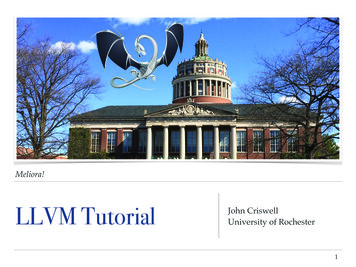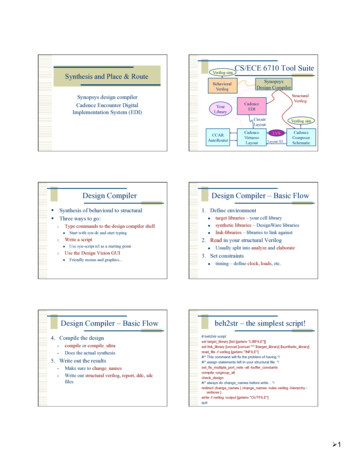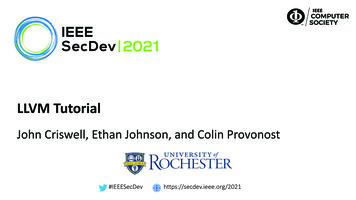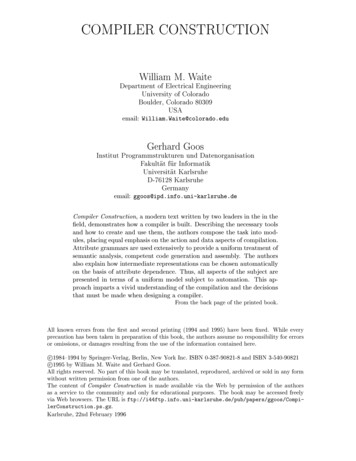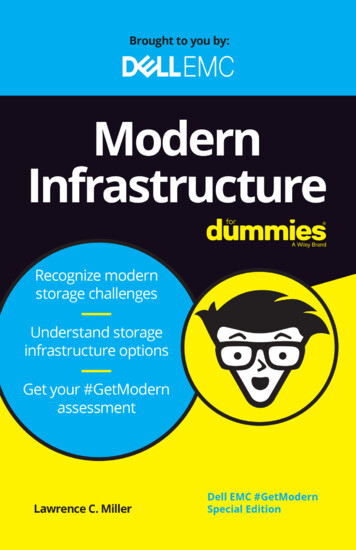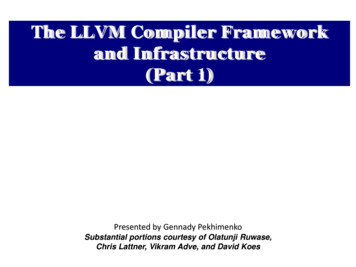
Transcription
The LLVM Compiler Frameworkand Infrastructure(Part 1)Presented by Gennady PekhimenkoSubstantial portions courtesy of Olatunji Ruwase,Chris Lattner, Vikram Adve, and David Koes
LLVM Compiler System The LLVM Compiler Infrastructure Provides reusable components for building compilers Reduce the time/cost to build a new compiler Build static compilers, JITs, trace-based optimizers, . The LLVM Compiler Framework End-to-end compilers using the LLVM infrastructure C and C are robust and aggressive: Java, Scheme and others are in development Emit C code or native code for X86, Sparc, PowerPC2
Three primary LLVM components The LLVM Virtual Instruction Set The common language- and target-independent IR Internal (IR) and external (persistent) representation A collection of well-integrated libraries Analyses, optimizations, code generators, JITcompiler, garbage collection support, profiling, A collection of tools built from the libraries Assemblers, automatic debugger, linker, codegenerator, compiler driver, modular optimizer, 3
Tutorial Overview Introduction to the running exampleLLVM C/C Compiler Overview High-level view of an example LLVM compiler The LLVM Virtual Instruction Set IR overview and type-system The Pass ManagerImportant LLVM Tools opt, code generator, JIT, test suite, bugpoint Assignment Overview4
Running example: arg promotionConsider use of by-reference parameters:int callee(const int &X) {return X 1;}int caller() {return callee(4);}We want:int callee(int X) {return X 1;}int caller() {return callee(4);}compiles toint callee(const int *X) {return *X 1; // memory load}int caller() {// stack objectint tmp;tmp 4;// memory storereturn callee(&tmp);} Eliminated load in callee Eliminated store in caller Eliminated stack slot for ‘tmp’5
Why is this hard? Requires interprocedural analysis: Must change the prototype of the callee Must update all call sites we must know all callers What about callers outside the translation unit? Requires alias analysis: Reference could alias other pointers in callee Must know that loaded value doesn’t change fromfunction entry to the load Must know the pointer is not being stored through Reference might not be to a stack object!6
Tutorial Overview Introduction to the running exampleLLVM C/C Compiler Overview High-level view of an example LLVM compiler The LLVM Virtual Instruction Set IR overview and type-system The Pass ManagerImportant LLVM Tools opt, code generator, JIT, test suite, bugpoint Assignment Overview7
The LLVM C/C Compiler From the high level, it is a standard compiler: Compatible with standard makefiles Uses GCC 4.2 C and C parserC filellvmgcc -emit-llvm.o filellvm linkerC filellvmg -emit-llvm.o fileCompile Time executableLink TimeDistinguishing features: Uses LLVM optimizers, not GCC optimizers .o files contain LLVM IR/bytecode, not machine code Executable can be bytecode (JIT’d) or machine code8
Looking into events at compile-timeC filellvmgcc.o fileC to ”ModifiedofGCCLLVMversionIRLLVMEmitsLLVM IR asVerifiertext fileParserLowers C AST to LLVM40 LLVM Analysis &Optimization PassesLLVM .bcFile WriterDead Global Elimination, IP Constant Propagation, DeadArgument Elimination, Inlining, Reassociation, LICM, LoopOpts, Memory Promotion, Dead Store Elimination, ADCE, 9
Looking into events at link-time.o filellvm linkerexecutable.o file.o file.o fileLLVMLinkerLink-timeOptimizer20 LLVM Analysis &Optimization PassesOptionally “internalizes”:marks most functions asinternal, to improve IPOPerfect place for argumentpromotion optimization!.bc file for LLVM JITNative CodeBackend“llc”C CodeBackend“llc –march c”Native executableC Compiler“gcc”NativeexecutableNOTE: Produces very ugly C. Officiallydeprecated, but still works fairly well.Link in native .o filesand libraries here10
Goals of the compiler design Analyze and optimize as early as possible: Compile-time opts reduce modify-rebuild-execute cycle Compile-time optimizations reduce work at link-time(by shrinking the program) All IPA/IPO make an open-world assumption Thus, they all work on libraries and at compile-time “Internalize” pass enables “whole program” optzn One IR (without lowering) for analysis & optzn Compile-time optzns can be run at link-time too! The same IR is used as input to the JITIR design is the key to these goals!11
Tutorial Overview Introduction to the running exampleLLVM C/C Compiler Overview High-level view of an example LLVM compiler The LLVM Virtual Instruction Set IR overview and type-system The Pass ManagerImportant LLVM Tools opt, code generator, JIT, test suite, bugpoint Assignment Overview12
Goals of LLVM IR Easy to produce, understand, and define!Language- and Target-Independent AST-level IR (e.g. ANDF, UNCOL) is not very feasible Every analysis/xform must know about ‘all’ languages One IR for analysis and optimization IR must be able to support aggressive IPO, loop opts,scalar opts, high- and low-level optimization! Optimize as much as early as possible Can’t postpone everything until link or runtime No lowering in the IR!13
LLVM Instruction Set Overview #1 Low-level and target-independent semantics RISC-like three address code Infinite virtual register set in SSA form Simple, low-level control flow constructs Load/store instructions with typed-pointers IR has text, binary, and in-memory formsloop:; preds %bb0, %loop%i.1 phi i32 [ 0, %bb0 ], [ %i.2, %loop ]%AiAddr getelementptr float* %A, i32 %i.1for (i 0; i N;call void @Sum(float %AiAddr, %pair* %P) i)%i.2 add i32 %i.1, 1Sum(&A[i], &P); %exitcond icmp eq i32 %i.1, %Nbr i1 %exitcond, label %outloop, label %loop14
LLVM Instruction Set Overview #2 High-level information exposed in the code Explicit dataflow through SSA form (more on SSAlater in the course) Explicit control-flow graph (even for exceptions) Explicit language-independent type-information Explicit typed pointer arithmetic Preserve array subscript and structure indexingloop:; preds %bb0, %loop%i.1 phi i32 [ 0, %bb0 ], [ %i.2, %loop ]%AiAddr getelementptr float* %A, i32 %i.1for (i 0; i N;call void @Sum(float %AiAddr, %pair* %P) i)%i.2 add i32 %i.1, 1Sum(&A[i], &P); %exitcond icmp eq i32 %i.1, %Nbr i1 %exitcond, label %outloop, label %loop15
LLVM Type System Details The entire type system consists of: Primitives: label, void, float, integer, Arbitrary bitwidth integers (i1, i32, i64) Derived: pointer, array, structure, function No high-level types: type-system is language neutral! Type system allows arbitrary casts: Allows expressing weakly-typed languages, like C Front-ends can implement safe languages Also easy to define a type-safe subset of LLVMSee also: docs/LangRef.html16
Lowering source-level types to LLVM Source language types are lowered: Rich type systems expanded to simple type system Implicit & abstract types are made explicit & concrete Examples of lowering: References turn into pointers: T& T* Complex numbers: complex float { float, float } Bitfields: struct X { int Y:4; int Z:2; } { i32 } Inheritance: class T : S { int X; } { S, i32 } Methods: class T { void foo(); } void foo(T*) Same idea as lowering to machine code17
LLVM Program Structure Module contains Functions/GlobalVariables Module is unit of compilation/analysis/optimization Function contains BasicBlocks/Arguments Functions roughly correspond to functions in C BasicBlock contains list of instructions Each block ends in a control flow instruction Instruction is opcode vector of operands All operands have types Instruction result is typed18
Our example, compiled to LLVMint callee(const int *X) {return *X 1; // load}int caller() {// on stackint T;T 4;// storereturn callee(&T);}internal int %callee(int* %X) {%tmp.1 load int* %X%tmp.2 add int %tmp.1, 1ret int %tmp.2}int %caller() {%T alloca intstore int 4, int* %T%tmp.3 call int %callee(int* %T)ret int %tmp.3}LinkerAll loads/stores“internalizes”areStack allocation ismostexplicitfunctionsin the inLLVMmostexplicit in LLVMrepresentationcases19
Our example, desired transformationinternal int %callee(int* %X) {%tmp.1 load int* %X%tmp.2 add int %tmp.1, 1ret int %tmp.2}int %caller() {%T alloca intstore int 4, int* %T%tmp.3 call int %callee(int* %T)ret int %tmp.3}Other transformationUpdateallsites m2reg)cleans up‘callee’forintotheallfunctioncallersthe restinternal int %callee(int %X.val) {%tmp.2 add int %X.val, 1ret int %tmp.2}int %caller() {%T alloca intstore int 4, int* %T%tmp.1 load int* %T%tmp.3 call int %callee(%tmp.1)ret int %tmp.3}int %caller() {%tmp.3 call int %callee(int 4)ret int %tmp.3}20
Tutorial Overview Introduction to the running exampleLLVM C/C Compiler Overview High-level view of an example LLVM compiler The LLVM Virtual Instruction Set IR overview and type-system The Pass ManagerImportant LLVM Tools opt, code generator, JIT, test suite, bugpoint Assignment Overview21
LLVM Coding Basics Written in modern C , uses the STL: Particularly the vector, set, and map classes LLVM IR is almost all doubly-linked lists: Module contains lists of Functions & GlobalVariables Function contains lists of BasicBlocks & Arguments BasicBlock contains list of Instructions Linked lists are traversed with iterators:Function *M for (Function::iterator I M- begin(); I ! M- end(); I) {BasicBlock &BB *I;.See also: docs/ProgrammersManual.html22
LLVM Pass Manager Compiler is organized as a series of ‘passes’: Each pass is one analysis or transformation Four types of Pass: ModulePass: general interprocedural pass CallGraphSCCPass: bottom-up on the call graph FunctionPass: process a function at a time BasicBlockPass: process a basic block at a time Constraints imposed (e.g. FunctionPass): FunctionPass can only look at “current function” Cannot maintain state across functionsSee also: docs/WritingAnLLVMPass.html23
Services provided by PassManager Optimization of pass execution: Process a function at a time instead of a pass at a time Example: three functions, F, G, H in input program, andtwo passes X & Y:“X(F)Y(F) X(G)Y(G) X(H)Y(H)” not “X(F)X(G)X(H) Y(F)Y(G)Y(H)” Process functions in parallel on an SMP (future work) Declarative dependency management: Automatically fulfill and manage analysis pass lifetimes Share analyses between passes when safe: e.g. “DominatorSet live unless pass modifies CFG” Avoid boilerplate for traversal of programSee also: docs/WritingAnLLVMPass.html24
Tutorial Overview Introduction to the running exampleLLVM C/C Compiler Overview High-level view of an example LLVM compiler The LLVM Virtual Instruction Set IR overview and type-system The Pass ManagerImportant LLVM Tools opt, code generator, JIT, test suite, bugpoint Assignment Overview25
LLVM tools: two flavors “Primitive” tools: do a single job llvm-as: Convert from .ll (text) to .bc (binary) llvm-dis: Convert from .bc (binary) to .ll (text) llvm-link: Link multiple .bc files together llvm-prof: Print profile output to human readers llvmc: Configurable compiler driver Aggregate tools: pull in multiple features gccas/gccld: Compile/link-time optimizers for C/C FE bugpoint: automatic compiler debugger llvm-gcc/llvm-g : C/C compilersSee also: docs/CommandGuide/26
opt tool: LLVM modular optimizer Invoke arbitrary sequence of passes: Completely control PassManager from command line Supports loading passes as plugins from .so filesopt -load foo.so -pass1 -pass2 -pass3 x.bc -o y.bc Passes “register” themselves:RegisterPass SimpleArgPromotion X("simpleargpromotion","Promote 'by reference' arguments to 'by value'"); Standard mechanism for obtaining parametersopt string StringVar(“sv", cl::desc(“Long description of param"),cl::value desc(“long flag"));From this, they are exposed through opt: opt -load libsimpleargpromote.so –help.-sccp- Sparse Conditional Constant Propagation-simpleargpromotion - Promote 'by reference' arguments to 'by-simplifycfg- Simplify the CFG.27
Tutorial Overview Introduction to the running exampleLLVM C/C Compiler Overview High-level view of an example LLVM compiler The LLVM Virtual Instruction Set IR overview and type-system The Pass ManagerImportant LLVM Tools opt, code generator, JIT, test suite, bugpoint Assignment Overview28
Assignment 1 - Practice Introduction to LLVM Install and play with it Learn interesting program properties Functions: name, arguments, return types, local orglobal Compute live values using iterative dataflow analysis29
Assignment 1 - Questions Building Control Flow Graph Data Flow Analysis Available Expressions Apply existing analysis New Dataflow Analysis30
Questions? Thank you31
Tutorial Overview Introduction to the running example LLVM C/C Compiler Overview High-level view of an example LLVM compiler The LLVM Virtual Instruction Set IR overview and type-system The Pass Manager Important LLVM Tools opt, code generator, JIT, test suite, bugpoint Assignment Overview . 4
